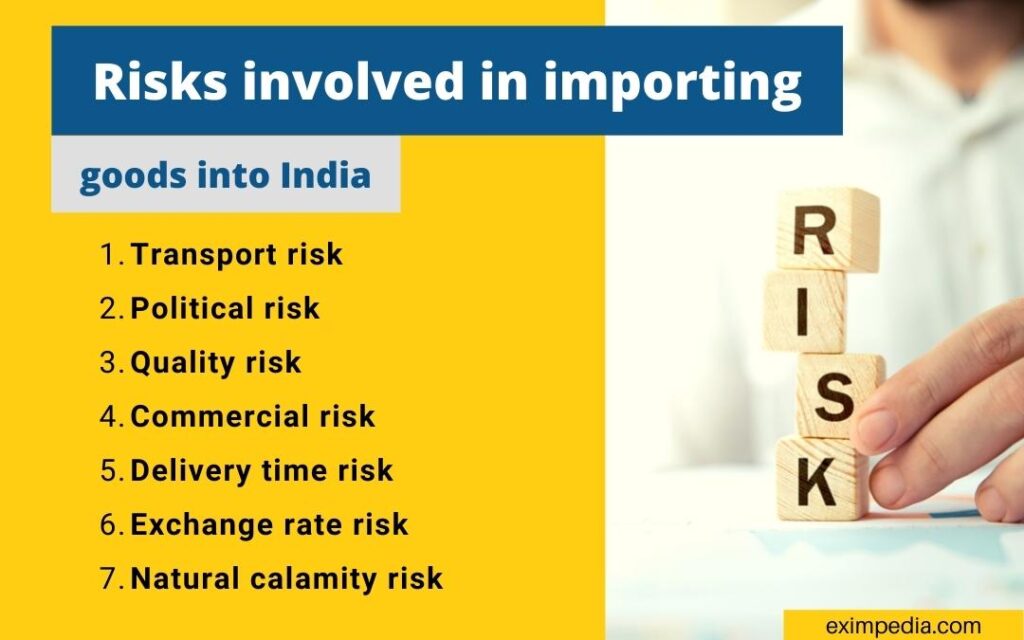If you are in an import business based in India, you must know that there are a lot of risks associated with imports. Here in this article, we have listed down the types of risks involved in importing any goods to India.
Table of Contents
7 types of risks involved in importing goods to India
These are all the types of risks associated while importing goods into India from any country. We have listed only the 8 most common import risks.
- Transport risk – The goods can be lost, damaged, or delayed during transit
- Political risk – If the government imposes a ban on certain products or restricts/prohibits importing from certain countries with immediate effect.
- Quality risk – the goods imported are not of the expected quality
- Commercial risk – If the product is not accepted by the market and is returned after use or the product simply won’t sell. Such risks happen due to inadequate research and know-how in the market.
- Delivery Time risk – on-time delivery is important for certain importers as traders must deliver goods to buyers and manufacturers must start production on time. Delivery time delay is one of the most common risks involved in importing goods.
- Exchange rate risk – This is basically associated when the foreign exchange wherein the exchange rate keeps changing frequently.
- Natural calamity – occurrence of a natural calamity might destroy the goods

Although risks are involved in every business but forming a strong business strategy to overcome such risks is important and that is why knowing all the risks involved in the import process is very important. Reading about risks should not demotivate you to start import but rather influence you to find solutions and grow in a better way.
To avoid any risks during importing goods into India, you must first know How to Import goods into India. You can check out the article on Eximpedia to know everything in detail about importing goods into India, the procedure of import in India, and How to start an import business in India. This will really help you in minimizing all the risks involved in importing goods to India.
How to minimize the risks involved in importing goods?
Yes, there are a lot of risks involved in the importing business but you must learn to do import risk management to minimize the risks involved in the import process.

1. Research the market and the product well before importing or placing the order to reduce the risks of importing and exporting and for managing risk involved in importing.
2. Order samples first from shortlisted suppliers before placing orders in bulk quantities to avoid quality risk. Negotiate and make it clear to the supplier about the quality you need and actions you will be taking if you are not satisfied with the quality.
3. To avoid commercial risk study if the product will work in the domestic market and if the buyers/manufacturers are satisfied with the samples of your product. If the product gets a good response, then order in the bulk.
4. To avoid legal and political risk, usually, government issues public notice/circular/notifications of any changes made in the Customs tariff well in advance. Read such notifications regularly for your product as and when issued so you can take the steps accordingly to avoid losses. You can submit a bond or get certain permissions if needed in case your shipment is in transit already.
5. To get on-time delivery, planning is very important. If you must deliver fast and the quantity is small you can import it by air, if you have time for delivery and the quantity is huge, you can import by sea. Calculate the time well in advance while placing the order. Confirm with the supplier the time required to ship the product and set the delivery time a little later than actual.
6. To avoid transport risk, make sure the transporter had a good reputation in the market. The one who uses technology in today’s world has already lowered the risk. With new tracking and weighing systems coming in more it is helping in reducing delivery risks. Use RFID tags on the packages to track each box. Transport risk is however unpredictable but taking steps in advance can help. You can read about the transportation chain in logistics to get a better understanding of the entire transportation chain of importing goods into India.
7. Import-export exchange rates are different from the normal currency exchange rates. Keep a track of the exchange rate notification which is issued every week on the CBIC portal by the board which should be kept track of. Take the help of the Customs Act 1962 to know when to apply which exchange rate to avoid confusion. Here is the link to track the exchange rates notification for imports – https://www.cbic.gov.in/Exchange-Rate-Notifications
8. Natural calamity is unpredictable and rare to happen. However, if anything of this sort happens it is always good to have insurance for your goods or mention in the contract about such events and an action plan on how to recover losses. This can be one of the most effective ways to reduce the risks involved in importing goods to India.
We hope this article was helpful for you to know about all the risks involved in importing goods into India.
If you have any more queries related to import, export, and foreign trade, please feel free to ask us anything by filling out the form below or submitting your queries by mail – [email protected]








We need about fifteen (15) to twenty different chapters for Imports/Export of Bangladesh, Sri Lanka, China and Middle east.
Can you provide us data selected chapters on monthly basis ?
Kindly mail us on – [email protected]